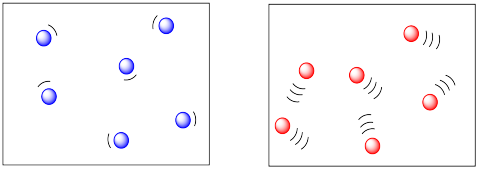
Reactivity in Chemistry
Reaction Kinetics
RK6. Collisions and Phase
Reaction rates depend on the energy required (the activation barrier) and the energy available. They also may involve collisions between molecules.
If two molecules need to collide in order for a reaction to take place, then factors that influence the ease of collisions will be important.
The more energy there is available to the molecules, the faster they will zip around. The faster they zip around, the more likely they are to bump into each other. So higher temperatures ought to lead to more collisions and a greater frequency of reactions between molecules. In the drawing below, the cold, sluggish molecules on the left don't appear to be in danger of colliding with anything, but the hot, zippy molecules on the right look like they are due for a crash at any time.

Figure RK6.1. The movement of molecules at different temperatures.
We already knew that higher temperatures increased reaction rates. This new observation is just an additional reason why temperature is important in kinetics.
Phase also has a pronounced effect on the mobility of molecules. Molecules in the gas phase are quite free to move around, and they do so pretty quickly. On the other hand, they are pretty well spread out. Nevertheless, collisions in the gas phase happen pretty easily, which might help gas-phase reactions happen more readily.
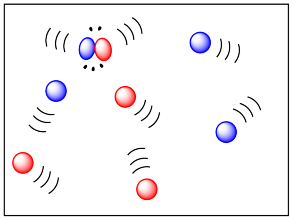
Figure RK6.2. A molecular collision in the gas phase.
At the opposite extreme, molecules in the solid phase are not very mobile at all. (Reactions may involve atoms or ions, rather than moleules, but the same arguments apply.) Not many collisions happen. As a result, reactions often happen extremely slowly in the solid state. Reactions are mostly limited to the grain boundaries: the surfaces of the grains, where they are in contact with each other. Nothing happens in the middle of a lump of solid, which remains unreacted.
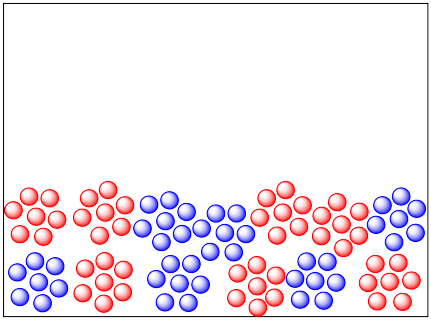
Figure RK6.3. A mixture of two different solids.
If you heat a solid up, the molecules can move around a little more. They may even leave their crystal lattice (if the solid is a crystalline one) and diffuse very slowly through the solid. Many solid state reactions are run at elevated temperature.
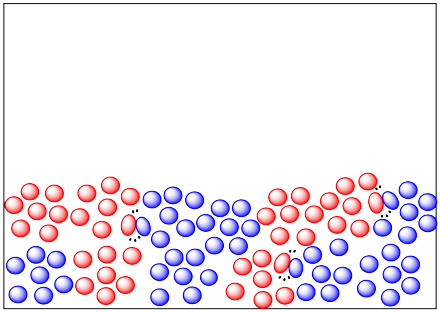
Figure RK6.4. Molecules reacting at the interface of two different solids.
There are also many solid state reactions that are conducted in combination with gas-phase reactants. The solid reactants are often heated in a furnace while gas-phase reactants flow over them.
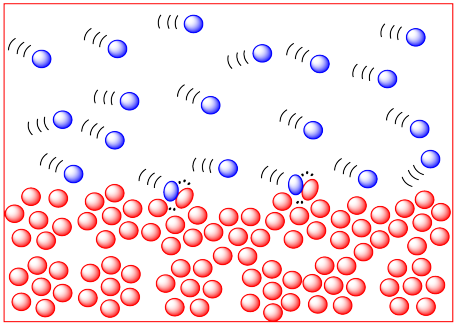
Figure RK6.5. A reaction between molecules in the gas phase and a solid surface.
Many reactions are performed in the liquid state, either because the reactants are already liquid of because the solid reactants are heated past their melting point. In the liquid phase, molecules are much more mobile and collisions are much more frequent than in the solid phase.
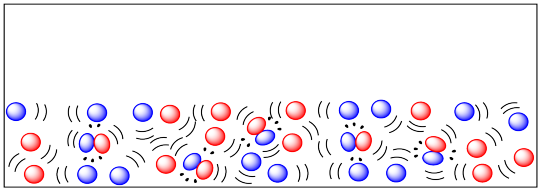
Figure RK6.6. Collisions between molecules in the liquid phase.
It is also very common to run reactions in solution. In solution, a compound that is meant to undergo reaction is dissolved in a solvent. The solvent needs to be a liquid at the temperature at which the reaction will be run, so that molecules will be very mobile, but will still be close together, so collisions are favoured.
There are many advantages to running reactions in solution. The reactant molecules are very mobile and pretty close together, so that collisions are facilitated. If the reaction is exothermic and gives of a lot of heat, the excess heat can be absorbed by the solvent molecules and carried away. That can be important in controlling reactions and avoiding decomposition. Also, we will see that the rate of collisions can be controlled by adding more solvent or less, in order to slow the reaction down or speed it up. In this way, the reaction rate can be controlled to some extent.
There are many liquids that are commonly used as solvents. Dichloromethane, toluene, dimethylformamide, tetrahydrofuran and acetonitrile are some common "organic" solvents, so called because they are based on carbon, which forms the basis of molecules in organisms. These different solvents offer a range of polarities, so different ones can dissolve different reactants.
Water may be the most common solvent on the planet, and it is non-toxic, so it is very appealing for use in large-scale, industrial reactions. However, it is not very good at dissolving non-polar reactants.
The reactant compound could be a liquid or a solid. It just has to have strong enough intermolecular attractions with the solvent molecules so that it can become dissolved. Individual molecules of the reactant become lost among the solvent molecules and swim around with ease.
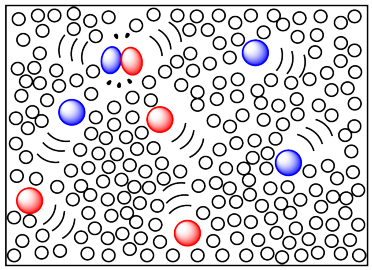
Figure RK6.7. Collisions between molecules in solution.
The disadvantage of using a solvent is that the solvent must be removed at the end of the reaction, so that the desired product can be isolated and used. That means the solvent may eventually be thrown away as waste. That practice is less efficient and less environmentally friendly, although the solvent could possibly be recycled.
One method of dissolving reactants that is potentially greener is the use of supercritical fluids. In this approach, gases such as carbon dioxide are pressurized until they turn into liquids. In this form, carbon dioxide is a pretty good solvent, and reactions can be run when reactants are dissolved in it. At the end of the reaction, a valve is opened, releasing the pressure, and the carbon dioxide turns back into a gas. It can be stored and re-pressurized for another reaction.
Problem RK6.1.
Diffusion in the solid state is greatly enhanced by defects in the crystal lattice. Show why with the following drawing.

Problem RK6.2.
The following drawing represents a reaction between molecules in the gas phase and molecules in the solid phase.
a) Which material is in the gas phase and which one is in the solid phase?
b) Both pictures contain the same mass of each material. One of these materials appears to be distributed differently in each picture, however. Explain how that difference may affect the reaction rate.

Problem RK6.3.
Three common solvents are shown below. Compare and contrast these three solvents in terms of how they interact with other molecules.
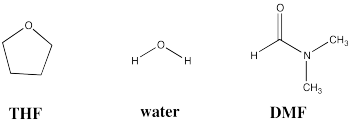
Problem RK6.4.
Indicate how well you think each of the three solvents in the above question (THF, water, DMF) could dissolve each of the following compounds. Justify your answers in terms of interactions between molecules.
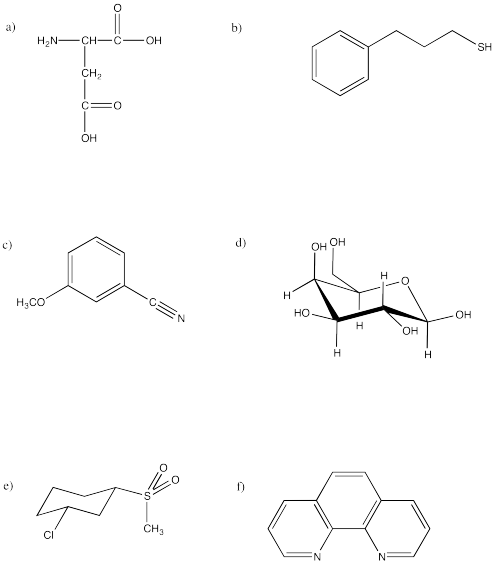
This site was written by Chris P. Schaller, Ph.D., College of Saint Benedict / Saint John's University (retired) with other authors as noted on individual pages. It is freely available for educational use.

Structure & Reactivity in Organic,
Biological and Inorganic Chemistry by
Chris Schaller
is licensed under a
Creative Commons Attribution-NonCommercial 3.0 Unported License.
Send corrections to cschaller@csbsju.edu
This material is based upon work supported by the National Science Foundation under Grant No. 1043566.
Any opinions, findings, and conclusions or recommendations expressed in this material are those of the author(s) and do not necessarily reflect the views of the National Science Foundation.
Navigation:
Back to Web Materials on Structure & Reactivity in Chemistry